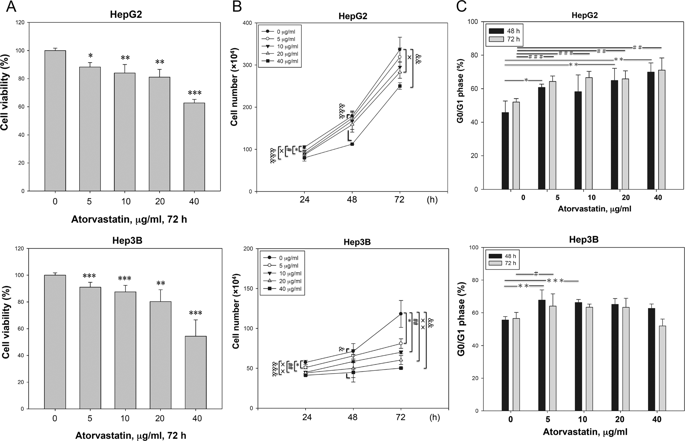Cell Death Discovery ( IF 7 ) Pub Date : 2020-03-30 , DOI: 10.1038/s41420-020-0252-9 Sin-Ting Wang, Shi-Wei Huang, Kuang-Ting Liu, Teng-Yu Lee, Jeng-Jer Shieh, Chun-Ying Wu

|
Hepatocellular carcinoma (HCC), a hepatic malignancy, has a poor prognosis and contributes to cancer-related death worldwide. Cellular senescence is an anticancer therapeutic strategy that causes irreversible cell cycle arrest and enables immune-mediated clearance of cancer cells. Atorvastatin, an HMG-CoA reductase inhibitor, has been shown to inhibit tumor growth and induce apoptosis or autophagy in malignant tumors. However, whether atorvastatin can induce HCC cell senescence and the mechanisms involved are poorly understood. The effects of atorvastatin-induced senescence were examined in both HCC cells and mouse xenograft models. The phenomenon and mechanism of senescence were examined by cell cycle analysis, senescence-associated β-galactosidase (SA-β-gal) staining and western blotting in HCC cells, and HCC tissues from mice were analyzed by immunohistochemical (IHC) staining. We demonstrated that atorvastatin induced cell growth inhibition and G0/G1 phase cell cycle arrest, leading to senescence in HCC cells. Atorvastatin-induced senescence was independent of p53, p14, and p16, and atorvastatin not only decreased the secretion of IL-6, a major senescence-associated secretory phenotype (SASP) factor, and the phosphorylation of STAT3 but also inhibited the expression of hTERT, a catalytic subunit of telomerase. Supplementation with exogenous IL-6 reversed both atorvastatin-induced suppression of STAT3 phosphorylation and hTERT expression and atorvastatin-induced senescence. Overexpression of constitutively activated STAT3 rescued HCC cells from atorvastatin-induced hTERT suppression and senescence. Moreover, atorvastatin decreased tumor growth in mouse xenograft models. Consistent with these results, atorvastatin decreased the IL-6, p-STAT3, and hTERT levels and increased β-gal expression in tumor sections. Taken together, these data indicate that atorvastatin can induce atypical cellular senescence in HCC cells to inhibit tumor growth, an effect mediated by downregulation of hTERT through suppression of the IL-6/STAT3 pathway.
中文翻译:

阿托伐他汀诱导的肝细胞癌衰老是通过抑制 IL-6/STAT3 通路下调 hTERT 介导的
肝细胞癌(HCC)是一种肝脏恶性肿瘤,预后不良,是全球癌症相关死亡的主要原因。细胞衰老是一种抗癌治疗策略,可导致不可逆的细胞周期停滞并实现免疫介导的癌细胞清除。阿托伐他汀是一种 HMG-CoA 还原酶抑制剂,已被证明可以抑制肿瘤生长并诱导恶性肿瘤细胞凋亡或自噬。然而,阿托伐他汀是否能诱导肝癌细胞衰老及其机制尚不清楚。在 HCC 细胞和小鼠异种移植模型中检查了阿托伐他汀诱导的衰老的影响。通过细胞周期分析、衰老相关β-半乳糖苷酶(SA-β-gal)染色和蛋白质印迹法研究肝癌细胞的衰老现象和机制,并通过免疫组织化学(IHC)染色分析小鼠肝癌组织。我们证明阿托伐他汀诱导细胞生长抑制和 G0/G1 期细胞周期停滞,导致 HCC 细胞衰老。阿托伐他汀诱导的衰老与 p53、p14 和 p16 无关,阿托伐他汀不仅减少主要衰老相关分泌表型 (SASP) 因子 IL-6 的分泌和 STAT3 的磷酸化,还抑制 hTERT 的表达,端粒酶的催化亚基。补充外源性 IL-6 可逆转阿托伐他汀诱导的 STAT3 磷酸化和 hTERT 表达抑制以及阿托伐他汀诱导的衰老。持续激活的 STAT3 过度表达可将 HCC 细胞从阿托伐他汀诱导的 hTERT 抑制和衰老中拯救出来。此外,阿托伐他汀还能降低小鼠异种移植模型中的肿瘤生长。与这些结果一致,阿托伐他汀降低了肿瘤切片中 IL-6、p-STAT3 和 hTERT 的水平并增加了 β-gal 的表达。综上所述,这些数据表明阿托伐他汀可以诱导 HCC 细胞非典型细胞衰老,从而抑制肿瘤生长,这是通过抑制 IL-6/STAT3 途径下调 hTERT 介导的效应。


























 京公网安备 11010802027423号
京公网安备 11010802027423号